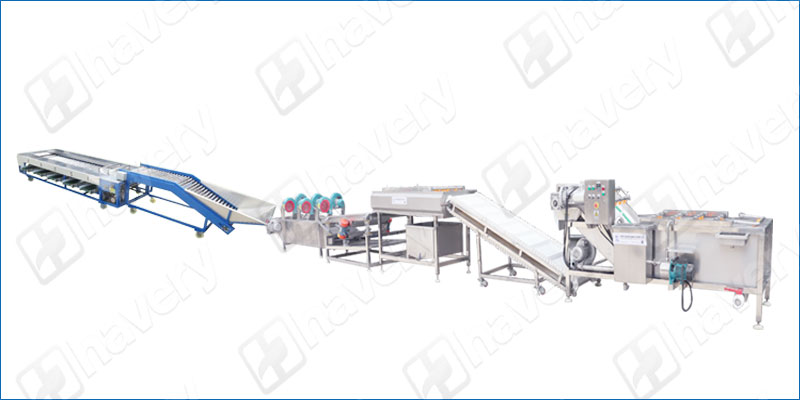The Potato Washing Drying and Grading Line is an automated industrial production line designed specifically for potato processing. Its goal is to ensure uniform quality, a clean appearance, and minimal damage through integrated processing—including washing, drying, and grading—for potato products suitable for retail, wholesale, or processing. This system balances efficiency with food safety standards, capable of processing large batches of potatoes while reducing manual labor and defective rates, thereby improving unit production cost-effectiveness. As a root vegetable, potatoes are prone to contamination with dirt, mud, and dust, and harbor potential impurities (pebbles, small shell fragments, grass roots, etc.). After harvest, they are prone to high moisture content and rot, and uneven grading can affect subsequent sales and processing quality. This production line is designed to address these issues.

Potato Washing Line Workflow
Receiving / Unloading → Pre-Cleaning (Dry) → Washing / Soaking / Brushing → Drying → Grading / Sorting → Inspection → Packaging or Further Processing
Receiving/Unloading: Potatoes are unloaded from harvest trailers or transport containers into hoppers or receiving funnels for a stable and orderly flow into further processing.
Pre-Cleaning (Dry): Dry pre-cleaning equipment such as drums or screens is used to remove large pieces of dirt, stones, and foreign matter, reducing the load of water washing.
Washing/Soaking/Brushing: A combination of air bubble washing, spraying, and soft and hard brushes is used to thoroughly remove surface mud, roots, and adhesions.
Drying: Air knife dryers remove excess surface moisture to reduce spoilage and facilitate packaging.
Grading/Sorting: Grading systems sort potatoes by size, shape, and defects.
Inspection: Manual or mechanical inspection tables (inspection tables/roller conveyor inspection tables) are used to remove defective or substandard potatoes.
Packing or Further Processing: Potatoes that meet specifications are transported to packaging (bagging, boxing, etc.) or further processing (peeling, slicing, frying, etc.).
Here is the potato washing line youtube video testing in our factory for your reference!!
Potato Washing Line Features
Multi-mode cleaning system: Incorporating multiple cleaning subsystems, including pre-treatment, air bubble washing, and spray scrubbing, effectively removes mud, sand, and surface deposits.
Efficient drying system: Utilizes powerful air ducts (air knives) and drying equipment such as felt rollers or sponge rollers to quickly reduce surface moisture on the potatoes.
Precision grading technology: Adjustable gaps between rollers, or the addition of manual visual grading, allows for grading by size, appearance, and defects.
Modular design and automated control: Each unit is logically connected, ensuring a stable belt/conveyor system. An automatic control interface monitors parameters such as temperature, humidity, and conveyor speed.
Potato Washing Drying And Grading Machien Advantages
Reduce labor costs and operational errors: High automation and minimal human intervention reduce grading errors and operational risks.
Improve cleanliness and food safety standards: Thoroughly remove soil and pathogens, reducing residues and meeting export and higher standards.
Extend shelf life and reduce product losses: The drying process reduces moisture-induced spoilage, mold, and mildew growth during transportation and storage.
Improve appearance consistency and market competitiveness: Standardized size and appearance grading make product sales and pricing easier to control, and retail packaging more attractive.
Benefits
Increased Profit Margins: Higher product quality and reduced waste allow for higher returns on the same investment.
Access to Premium Markets: Clean, uniformly graded potatoes are more readily accepted and adopted by supermarkets, exporters, and processors.
Improved Operational Efficiency: Streamlining the entire production line increases output, reducing processing time and costs per potato.
Reduced Returns, Complaints, and Internal Waste: Inspection and grading processes allow for the timely removal of substandard products, reducing customer dissatisfaction and internal waste.
Evidence
Similar potato washing, drying, and grading lines from the industry have an hourly processing capacity of over 5,000 kg (or 5 tons/hour), and their washing, drying, and grading performance has been recognized by market players.
After one farm added manual visual grading capabilities, the screening rate of damaged potatoes (such as those with spots, dry cuts, green skin, and mold) significantly increased, resulting in higher quality yields and higher selling prices.
The multi-mode washing and scrubbing combination thoroughly removes difficult-to-clean surface impurities such as mud, roots, and other impurities. The cleaned potatoes have a brighter and cleaner appearance, resulting in retailers praising their packaging as “eye-catching.”
The drying process reduces actual losses caused by spoilage and mold during transportation due to humidity. According to user feedback and case studies, the overall shelf life of the product has been extended by several days, with significant reductions in storage losses. (Although specific figures vary depending on the variety and environment.)
Conclusion
Overall, this Potato Washing, Drying, and Grading Line utilizes a carefully designed washing, drying, and grading process optimized for the unique characteristics of root crops like potatoes: heavy soil content, low trash content, high moisture content, and a wide variety of shapes and sizes. Its key advantages include improved product appearance and grade consistency, reduced waste, and increased efficiency, all while meeting food safety and market standards. This is a valuable investment for farms, food processors, or exporters seeking to improve potato product quality, enter higher-end markets, or optimize production costs.
If you would like to learn more about the specific configuration parameters of this line (e.g., processing capacity/tons/hour, graded size/defect detection capabilities, energy consumption, material components, and level of automation), please contact us online. We will provide detailed technical drawings and a quote, and provide free customized solutions.




